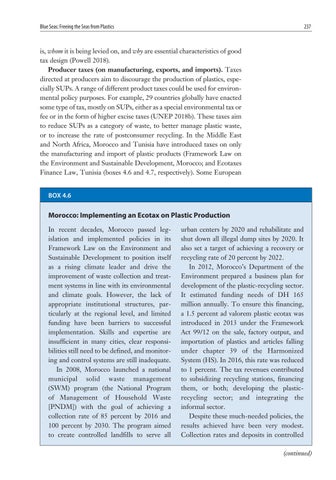Blue Seas: Freeing the Seas from Plastics
237
is, whom it is being levied on, and why are essential characteristics of good tax design (Powell 2018). Producer taxes (on manufacturing, exports, and imports). Taxes directed at producers aim to discourage the production of plastics, especially SUPs. A range of different product taxes could be used for environmental policy purposes. For example, 29 countries globally have enacted some type of tax, mostly on SUPs, either as a special environmental tax or fee or in the form of higher excise taxes (UNEP 2018b). These taxes aim to reduce SUPs as a category of waste, to better manage plastic waste, or to increase the rate of postconsumer recycling. In the Middle East and North Africa, Morocco and Tunisia have introduced taxes on only the manufacturing and import of plastic products (Framework Law on the Environment and Sustainable Development, Morocco; and Ecotaxes Finance Law, Tunisia (boxes 4.6 and 4.7, respectively). Some European BOX 4.6
Morocco: Implementing an Ecotax on Plastic Production In recent decades, Morocco passed legislation and implemented policies in its Framework Law on the Environment and Sustainable Development to position itself as a rising climate leader and drive the improvement of waste collection and treatment systems in line with its environmental and climate goals. However, the lack of appropriate institutional structures, particularly at the regional level, and limited funding have been barriers to successful implementation. Skills and expertise are insufficient in many cities, clear responsibilities still need to be defined, and monitoring and control systems are still inadequate. In 2008, Morocco launched a national municipal solid waste management (SWM) program (the National Program of Management of Household Waste [PNDM]) with the goal of achieving a collection rate of 85 percent by 2016 and 100 percent by 2030. The program aimed to create controlled landfills to serve all
urban centers by 2020 and rehabilitate and shut down all illegal dump sites by 2020. It also set a target of achieving a recovery or recycling rate of 20 percent by 2022. In 2012, Morocco’s Department of the Environment prepared a business plan for development of the plastic-recycling sector. It estimated funding needs of DH 165 million annually. To ensure this financing, a 1.5 percent ad valorem plastic ecotax was introduced in 2013 under the Framework Act 99/12 on the sale, factory output, and importation of plastics and articles falling under chapter 39 of the Harmonized System (HS). In 2016, this rate was reduced to 1 percent. The tax revenues contributed to subsidizing recycling stations, financing them, or both; developing the plasticrecycling sector; and integrating the informal sector. Despite these much-needed policies, the results achieved have been very modest. Collection rates and deposits in controlled (continued)






